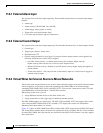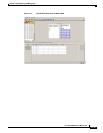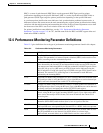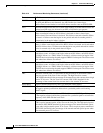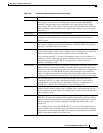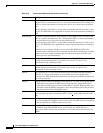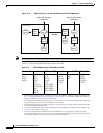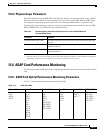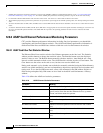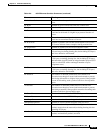
12-6
Cisco ONS 15600 Reference Manual, R7.2
Chapter 12 Performance Monitoring
12.4 Performance-Monitoring Parameter Definitions
ES-PFE Far-End STS Path Errored Seconds (ES-PFE) is a count of the seconds when at least
one STS path BIP error was detected. An AIS-P defect (or a lower-layer,
traffic-related, far-end defect) or an LOP-P defect can also cause an STS ES-PFE.
ES-S Section Errored Seconds (ES-S) is a count of the number of seconds when at least one
section-layer BIP error was detected or an SEF or LOS defect was present.
FC-L Line Failure Count (FC-L) is a count of the number of near-end line failure events. A
failure event begins when an AIS-L failure is declared or when a lower-layer,
traffic-related, near-end failure is declared. This failure event ends when the failure
is cleared. A failure event that begins in one period and ends in another period is
counted only in the period where it begins.
FC-LFE Far-End Line Failure Count (FC-LFE) is a count of the number of far-end line failure
events. A failure event begins when Line RFI-L failure is declared, and it ends when
the RFI-L failure clears. A failure event that begins in one period and ends in another
period is counted only in the period where it began.
FC-P Near-End STS Path Failure Counts (FC-P) is a count of the number of near-end STS
path failure events. A failure event begins when an AIS-P failure, an LOP-P failure,
a UNEQ-P failure, or a TIM-P failure is declared. A failure event also begins if the
STS PTE that is monitoring the path supports ERDI-P for that path. The failure event
ends when these failures are cleared.
FC-PFE Far-End STS Path Failure Counts (FC-PFE) is a count of the number of near-end STS
path failure events. A failure event begins when an AIS-P failure, an LOP-P failure,
a UNEQ-P failure, or a TIM-P failure is declared. A failure event also begins if the
STS PTE that is monitoring the path supports ERDI-P for that path. The failure event
ends when these failures are cleared.
LBC Laser Bias Current (LBC) is represented by the percentage of the normal (100%)
laser bias current of the laser on the card port. The high laser bias current
(LBC-HIGH) threshold is the percentage of the normal laser bias current when a high
current TCA occurs. The low laser bias current (LBC-LOW) threshold is the
percentage of the normal laser bias current when a low current TCA occurs.
NPJC-PDET Negative Pointer Justification Count, STS Detected (NPJC-PDET).
NPJC-PDET-P Negative Pointer Justification Count, STS Path Detected (NPJC-Pdet-P) is a count of
the negative pointer justifications detected on a particular path in an incoming
SONET signal.
NPJC-PGEN-P Negative Pointer Justification Count, STS Path Generated (NPJC-Pgen-P) is a count
of the negative pointer justifications generated for a particular path to reconcile the
frequency of the SPE with the local clock.
OPT Optical Power Transmitted (OPT) is represented by the percentage of the normal
(100%) optical transmit power of the laser on the card port. The high optical power
transmitted (OPT-HIGH) threshold is the percentage of the normal transmit optical
power when a high transmit power TCA occurs. The low optical power transmitted
(OPT-LOW) threshold is the percentage of the normal transmit optical power when
a low transmit power TCA occurs.
Table 12-2 Performance Monitoring Parameters (continued)
Parameter Definition



